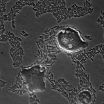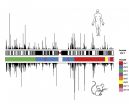Endangered green turtles may feed, reside at Peru's central, northern coast
2014-11-19
Peruvian coastal waters may provide suitable habitat that may help the recovery of endangered South Pacific green turtles, according to a study published November 19, 2014 in the open-access journal PLOS ONE by Ximena Velez-Zuazo from University of Puerto Rico and colleagues.
Green turtles inhabit tropical and subtropical coastal waters around the world. The authors of this study worked to identify suitable habitat for the endangered species by measuring two populations off the Peruvian coast from 2010 to 2013 in potentially important feeding grounds.
The researchers ...
Florida harvester ants regularly relocate
2014-11-19
Florida harvester ants move and construct a similar subterranean nest about once a year, according to a study published November 19, 2014 in the open-access journal PLOS ONE by Walter Tschinkel from Florida State University.
The Florida harvester ant excavates up to 2 meter deep nests in the sandy soils of the Gulf and Atlantic coastal plains. Scientists tracked and mapped nest relocations of over 400 colonies in a north Florida coastal plains pine forest from 2010 to 2013 and monitored the progress of entire relocations of 20 of these nests.
The researchers found that ...
Gut microbiota influences blood-brain barrier permeability
2014-11-19
A new study in mice, conducted by researchers at Sweden's Karolinska Institutet together with colleagues in Singapore and the United States, shows that our natural gut-residing microbes can influence the integrity of the blood-brain barrier, which protects the brain from harmful substances in the blood. According to the authors, the findings provide experimental evidence that our indigenous microbes contribute to the mechanism that closes the blood-brain barrier before birth. The results also support previous observations that gut microbiota can impact brain development ...
Salk scientists deliver a promising one-two punch for lung cancer
2014-11-19
LA JOLLA--Scientists at the Salk Institute have discovered a powerful one-two punch for countering a common genetic mutation that often leads to drug-resistant cancers. The dual-drug therapy--with analogs already in use for other diseases--doubled the survival rate of mice with lung cancer and halted cancer in pancreatic cells.
Lung cancer, which affects nonsmokers as well as smokers, is the most common cancer worldwide, causing 1.6 million deaths a year, far more than pancreatic, breast and colon cancer combined. About 30 percent of the most common type of lung cancer ...
Research shows why antidepressant may be effective in postpartum depression
2014-11-19
WASHINGTON, D.C. - An antidepressant commonly prescribed for women with postpartum depression may restore connections between cells in brain regions that are negatively affected by chronic stress during pregnancy, new research suggests.
Ohio State University scientists found that rats that had been chronically stressed during pregnancy showed depressive-like behaviors after giving birth, and structures in certain areas of their brains were less complex than in unstressed rats. After receiving the drug for three weeks, these rats had no depressive symptoms and neurons ...
People's movement perturbed during, but similar after Hurricane Sandy
2014-11-19
New York City residents' movement around the city was perturbed, but resumed less than 24-hours after Hurricane Sandy, according to a study published November 19, 2014 in the open-access journal PLOS ONE by Qi Wang and John Taylor from Virginia Tech.
Tropical cyclones, including hurricanes and typhoons, are severe natural disasters that can cause tremendous loss of human life and suffering. Our knowledge of peoples' movements during natural disasters is so far limited due to a lack of data. The authors of this article studied human mobility using movement data from individuals ...
New technology may speed up, build awareness of landslide risks
2014-11-19
CORVALLIS, Ore. - Engineers have created a new way to use lidar technology to identify and classify landslides on a landscape scale, which may revolutionize the understanding of landslides in the U.S. and reveal them to be far more common and hazardous than often understood.
The new, non-subjective technology, created by researchers at Oregon State University and George Mason University, can analyze and classify the landslide risk in an area of 50 or more square miles in about 30 minutes - a task that previously might have taken an expert several weeks to months. It can ...
Study: Environmental bleaching impairs long-term coral reproduction
2014-11-19
TALLAHASSEE, Fla. -- A new study by a Florida State University biologist shows that bleaching events brought on by rising sea temperatures are having a detrimental long-term impact on coral.
Professor Don Levitan, chair of the Department of Biological Science, writes in the latest issue of Marine Ecology Progress Series that bleaching -- a process where high water temperatures or UV light stresses the coral to the point where it loses its symbiotic algal partner that provides the coral with color -- is also affecting the long-term fertility of the coral.
"Even corals ...
Unique sense of 'touch' gives a prolific bacterium its ability to infect anything
2014-11-19
New research has found that one of the world's most prolific bacteria manages to afflict humans, animals and even plants by way of a mechanism not before seen in any infectious microorganism -- a sense of touch. This unique ability helps make the bacteria Pseudomonas aeruginosa ubiquitous, but it also might leave these antibiotic-resistant organisms vulnerable to a new form of treatment.
Pseudomonas is the first pathogen found to initiate infection after merely attaching to the surface of a host, Princeton University and Dartmouth College researchers report in the journal ...
Social sensing game detects classroom bullies
2014-11-19
A social sensing game created at Illinois allows researchers to study natural interactions between children, collect large amounts of data about those interactions and test theories about youth aggression and victimization.
The game's behavior analyses effectively identify classroom bullies, even revealing peer aggression that goes undetected by traditional research methods, the researchers say.
The game's developers say it is an improvement over traditional research methods, such as questionnaires, which do not assess interactions between youth in real time.
"What ...
Scientists map mouse genome's 'mission control centers'
2014-11-19
When the mouse and human genomes were catalogued more than 10 years ago, an international team of researchers set out to understand and compare the "mission control centers" found throughout the large stretches of DNA flanking the genes. Their long-awaited report, published Nov. 19 in the journal Nature suggests why studies in mice cannot always be reproduced in humans. Importantly, the scientists say, their work also sheds light on the function of DNA's regulatory regions, which are often to blame for common chronic human diseases.
"Most of the differences between mice ...
Natural gut viruses join bacterial cousins in maintaining health and fighting infections
2014-11-19
Microbiologists at NYU Langone Medical Center say they have what may be the first strong evidence that the natural presence of viruses in the gut -- or what they call the 'virome' -- plays a health-maintenance and infection-fighting role similar to that of the intestinal bacteria that dwell there and make up the "microbiome."
In a series of experiments in mice that took two years to complete, the NYU Langone team found that infection with the common murine norovirus, or MNV, helped mice repair intestinal tissue damaged by inflammation and helped restore the gut's immune ...
Stanford researchers compare mammals' genomes to aid human clinical research
2014-11-19
For years, scientists have considered the laboratory mouse one of the best models for researching disease in humans because of the genetic similarity between the two mammals. Now, researchers at the Stanford University School of Medicine have found that the basic principles of how genes are controlled are similar in the two species, validating the mouse's utility in clinical research.
However, there are important differences in the details of gene regulation that distinguish us as a species.
"At the end of the day, a lot of the genes are identical between a mouse and ...
Of mice, not men
2014-11-19
For more than a century, the laboratory mouse (Mus musculus) has stood in for humans in experiments ranging from deciphering disease and brain function to explaining social behaviors and the nature of obesity. The small rodent has proven to be an indispensable biological tool, the basis for decades of profound scientific discovery and medical progress.
But in new findings published online Nov. 19 in the journal Nature, researchers at the University of California, San Diego School of Medicine and Ludwig Cancer Research, with colleagues across the country and world, have ...
New understanding of genetic replication could help in the fight against cancer
2014-11-19
TALLAHASSEE, Fla. -- A new line of research from a team at Florida State University is pushing the limits on what the world knows about how human genetic material is replicated and what that means for people with diseases where the replication process is disrupted, such as cancer.
The team, lead by Department of Biological Sciences Professor David Gilbert and post-doctoral researcher Ben Pope, has taken an in-depth look at how DNA and the associated genetic material replicate and organize within a cell's nucleus. Their work could be especially crucial for doctors and ...
Crops help to drive greater seasonal change in CO2 cycle
2014-11-19
BOSTON - November 19, 2014 - Each year in the Northern Hemisphere, levels of atmospheric carbon dioxide (CO2) drop in the summer as plants inhale, and then climb again as they exhale and decompose after their growing season. Over the past 50 years, the size of this seasonal swing has increased by as much as half, for reasons that aren't fully understood. Now a team of researchers led by Boston University scientists has shown that agricultural production may generate up to a quarter of the increase in this seasonal carbon cycle, with corn playing a leading role.
"In the ...
What agricultural 'ecosystems on steroids' are doing to the air
2014-11-19
ANN ARBOR--In a study that identifies a new, "direct fingerprint" of human activity on Earth, scientists have found that agricultural crops play a big role in seasonal swings of carbon dioxide in the atmosphere.
The new findings from Boston University, the University of Michigan and other institutions reveal a nuance in the carbon cycle that could help scientists understand and predict how Earth's vegetation will react as the globe warms.
Agriculture amplifies carbon dioxide fluctuations that happen every year. Plants suck up CO2 in the spring and summer as they blossom. ...
Thin film produces new chemistry in 'nanoreactor'
2014-11-19
Physicists at the University of Groningen led by Professor of Functional Nanomaterials Beatriz Noheda have discovered a new manganese compound that is produced by tension in the crystal structure of terbium manganese oxide. The technique they used to create this new material could open the way to new nanoscale circuits. Their findings were published on 20 November 2014 in the journal Nature.
The researchers grew a very thin layer (no more than a few dozen atoms thick) of the terbium manganese oxide crystal on a thicker base layer of strontium titanium oxide. This base ...
Business culture in banking industry favors dishonest behavior
2014-11-19
In the past years, there have often been cases of fraud in the banking industry, which have led to a considerable loss of image for banks. Are bank employees by nature less honest people? Or does the business culture in the banking sector favor dishonest behavior? These questions formed the basis for a new study by Alain Cohn, Ernst Fehr, and Michel Maréchal from the Department of Economics at the University of Zurich. Their results show that bank employees are in principle not more dishonest than their colleagues in other industries. The findings indicate, however, ...
New view of mouse genome finds many similarities, striking differences with human genome
2014-11-19
Looking across evolutionary time and the genomic landscapes of humans and mice, an international group of researchers has found powerful clues to why certain processes and systems in the mouse - such as the immune system, metabolism and stress response - are so different from those in people. Building on years of mouse and gene regulation studies, they have developed a resource that can help scientists better understand how similarities and differences between mice and humans are written in their genomes.
Their findings - reported by the mouse ENCODE Consortium online ...
Variation in expression of thousands of genes kept under tight constraint in mice, humans
2014-11-19
Cold Spring Harbor, NY - An international team of researchers led by Professor Thomas R. Gingeras of Cold Spring Harbor Laboratory (CSHL) and Roderic Guigo (Centre For Genomic Regulation, Barcelona) has identified some 6600 genes whose level of expression varies within a comparatively restricted range in humans and mice.
This constraint in expression, they found, is unrelated to the degree of similarity of their gene sequences. The 6600 genes represent about one-third of the total set of genes that are typically active in cells across tissues in both species, irrespective ...
Humans and mice: So similar but yet so different
2014-11-19
This news release is available in Spanish. A group of international researchers has just discovered the keys to explaining why certain processes and systems in mice, like the immune system, metabolism and stress response, are so different to those in humans. The scientists have detailed the functional parts of the mouse genome and have compared them with those in humans. A whole set of data has come out of this - which is now to available to the scientific community - which will be significant for research into mammalian biology as well as the study of human illness ...
Experts suggest single dose IV medication as first-choice treatment for Paget's disease
2014-11-19
Washington, DC--The Endocrine Society today issued a Clinical Practice Guideline (CPG) for the diagnosis and treatment of Paget's disease of the bone, a condition where one or more bones in the body become oversized and weak.
The CPG, entitled "Paget's Disease of Bone: An Endocrine Society Clinical Practice Guideline," will appear in the December 2014 issue of the Journal of Clinical Endocrinology and Metabolism (JCEM), a publication of the Endocrine Society.
As part of its normal processes, the body breaks down old bone tissue and replaces it with new bone. When someone ...
Successful outcome prompts early end to sickle cell anemia clinical trial
2014-11-19
CINCINNATI - Conclusive data show that hydroxyurea therapy offers safe and effective disease management of sickle cell anemia (SCA) and reduces the risk of stroke, prompting early termination by the National Heart Lung and Blood Institute (NHLBI) of a key clinical trial studying the drug's efficacy.
NHLBI officials issued the announcement today, about one year before the study was originally scheduled to end. Going by the title TWiTCH (TCD With Transfusions Changing to Hydroxyurea), the Phase III randomized clinical trial at 25 medical centers in the U.S. and Canada compared ...
Study: Teens who mature early at greater risk of depression
2014-11-19
CHAMPAIGN, Ill. -- Youth who enter puberty ahead of their peers are at heightened risk of depression, although the disease develops differently in girls than in boys, a new study suggests.
Early maturation triggers an array of psychological, social-behavioral and interpersonal difficulties that predict elevated levels of depression in boys and girls several years later, according to research by led by psychology professor Karen D. Rudolph at the University of Illinois.
Rudolph and her colleagues measured pubertal timing and tracked levels of depression among more than ...
[1] ... [3062]
[3063]
[3064]
[3065]
[3066]
[3067]
[3068]
[3069]
3070
[3071]
[3072]
[3073]
[3074]
[3075]
[3076]
[3077]
[3078]
... [8705]
Press-News.org - Free Press Release Distribution service.









